人教版(2019))高中英语必修第一册Welcome unit 基本句型课件(31张ppt)
文档属性
| 名称 | 人教版(2019))高中英语必修第一册Welcome unit 基本句型课件(31张ppt) | 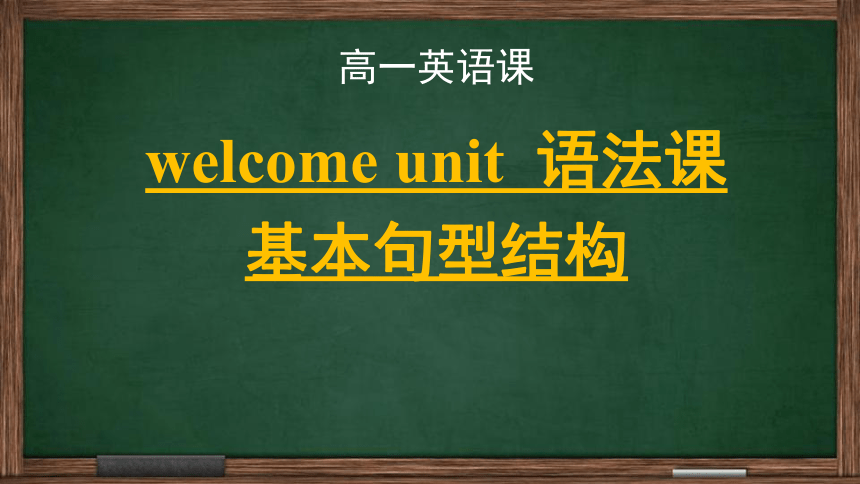 | |
| 格式 | zip | ||
| 文件大小 | 567.4KB | ||
| 资源类型 | 教案 | ||
| 版本资源 | 人教版(2019) | ||
| 科目 | 英语 | ||
| 更新时间 | 2022-09-05 12:29:13 | ||
图片预览

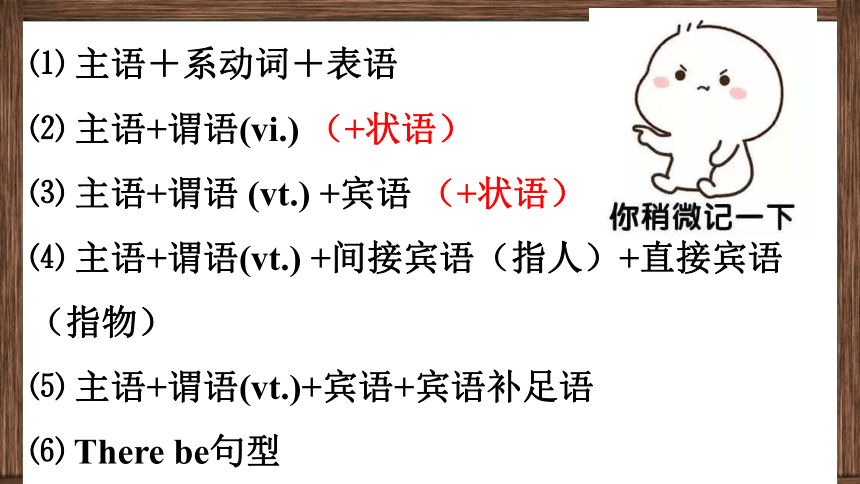
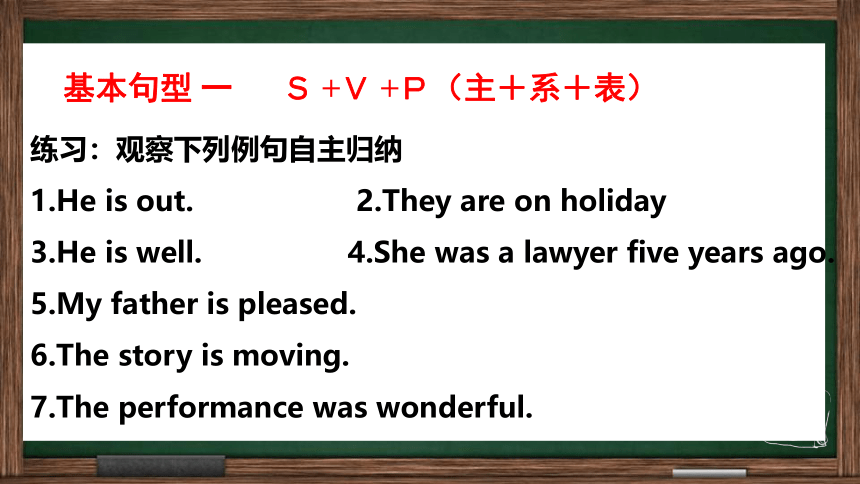
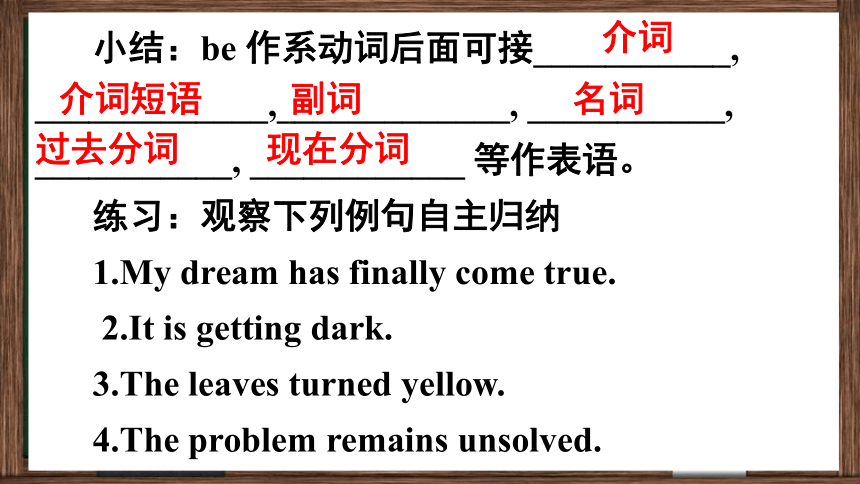
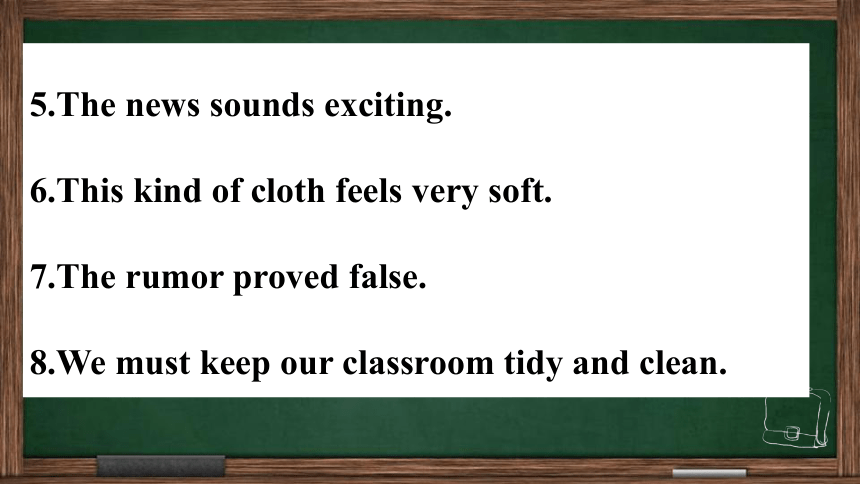
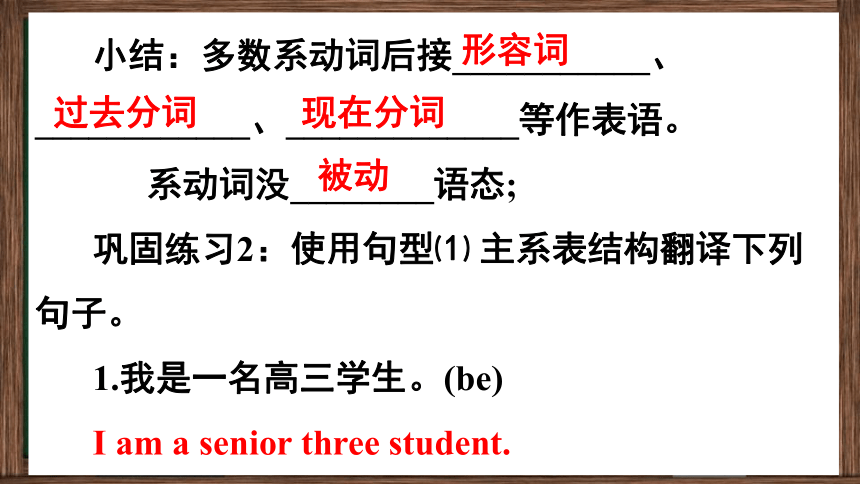
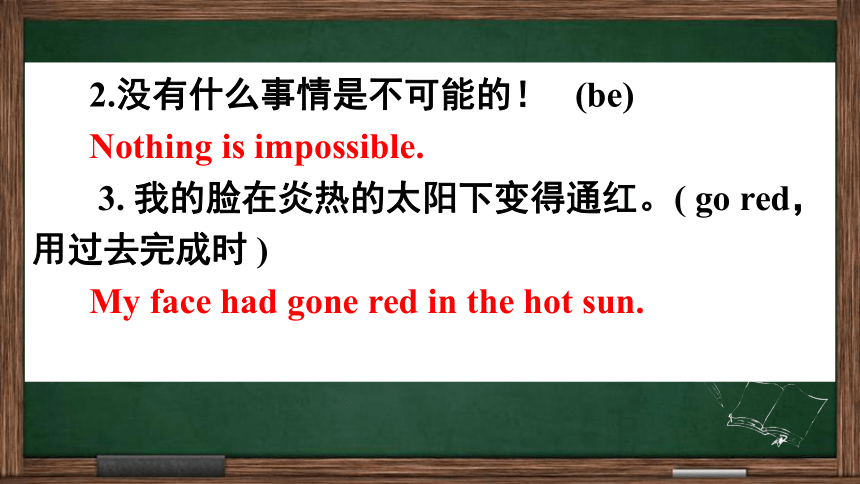
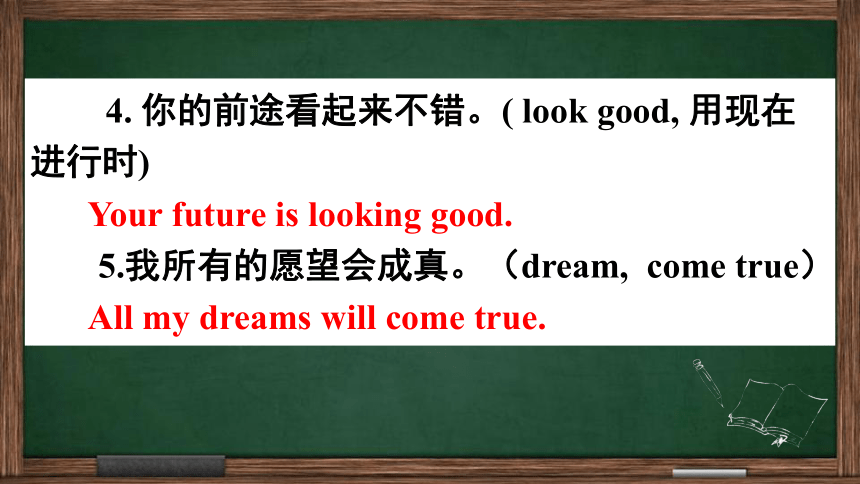
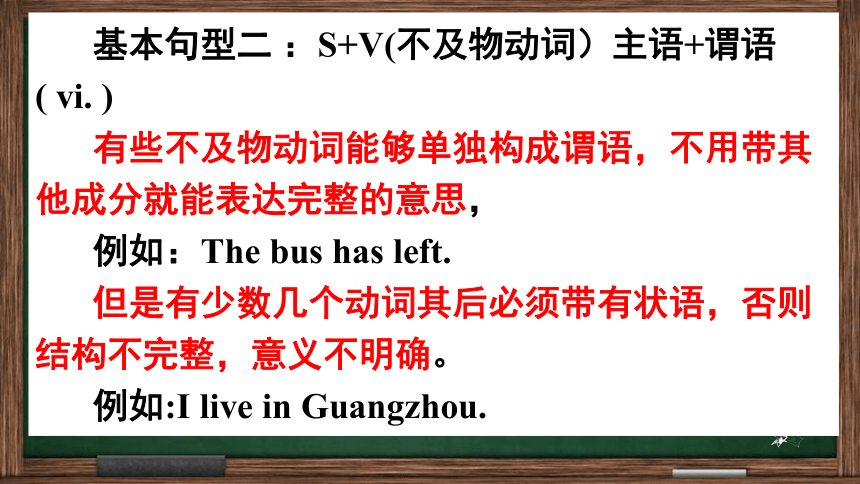
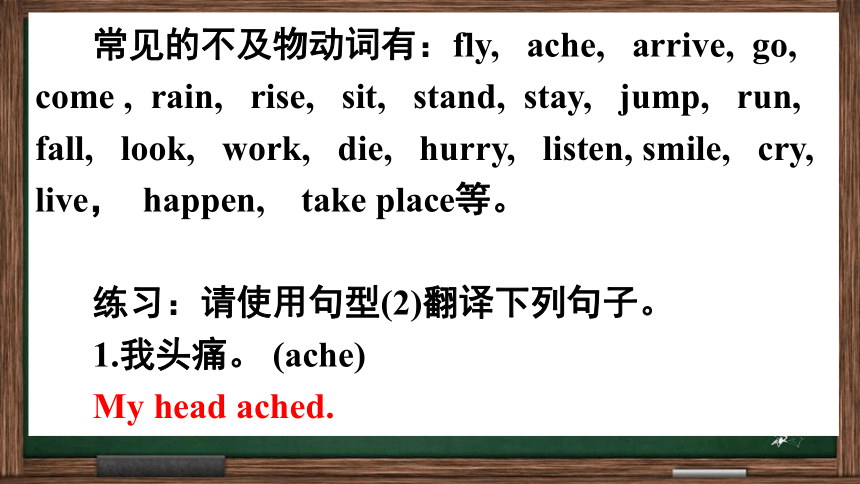
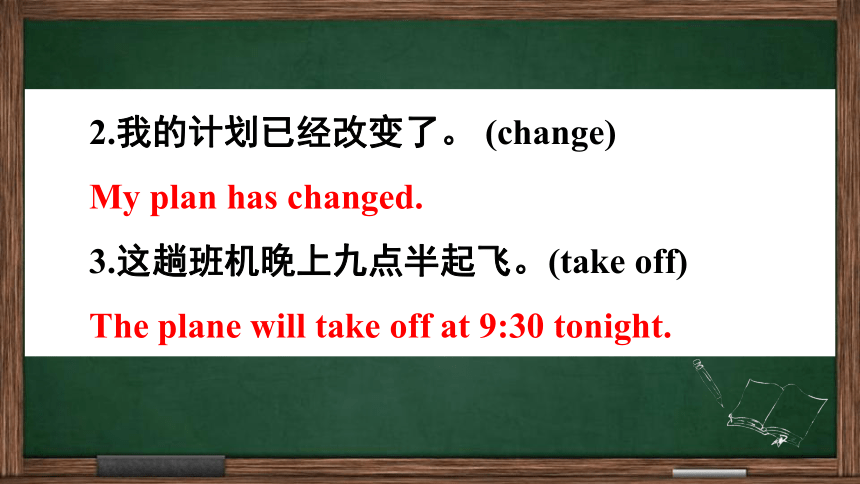

文档简介
(共31张PPT)
高一英语课
welcome unit 语法课
基本句型结构
⑴ 主语+系动词+表语
⑵ 主语+谓语(vi.) (+状语)
⑶ 主语+谓语 (vt.) +宾语 (+状语)
⑷ 主语+谓语(vt.) +间接宾语(指人)+直接宾语(指物)
⑸ 主语+谓语(vt.)+宾语+宾语补足语
⑹ There be句型
基本句型 一 S +V +P(主+系+表)
练习:观察下列例句自主归纳
1.He is out. 2.They are on holiday
3.He is well. 4.She was a lawyer five years ago.
5.My father is pleased.
6.The story is moving.
7.The performance was wonderful.
小结:be 作系动词后面可接___________, _____________,_____________, ___________, ___________, ____________ 等作表语。
练习:观察下列例句自主归纳
1.My dream has finally come true.
2.It is getting dark.
3.The leaves turned yellow.
4.The problem remains unsolved.
介词
介词短语
副词
名词
过去分词
现在分词
5.The news sounds exciting.
6.This kind of cloth feels very soft.
7.The rumor proved false.
8.We must keep our classroom tidy and clean.
小结:多数系动词后接___________、____________、_____________等作表语。
系动词没________语态;
巩固练习2:使用句型⑴ 主系表结构翻译下列句子。
1.我是一名高三学生。(be)
I am a senior three student.
形容词
过去分词
现在分词
被动
2.没有什么事情是不可能的! (be)
Nothing is impossible.
3. 我的脸在炎热的太阳下变得通红。( go red,用过去完成时 )
My face had gone red in the hot sun.
4. 你的前途看起来不错。( look good, 用现在进行时)
Your future is looking good.
5.我所有的愿望会成真。(dream, come true)
All my dreams will come true.
基本句型二 :S+V(不及物动词)主语+谓语( vi. )
有些不及物动词能够单独构成谓语,不用带其他成分就能表达完整的意思,
例如:The bus has left.
但是有少数几个动词其后必须带有状语,否则结构不完整,意义不明确。
例如:I live in Guangzhou.
常见的不及物动词有:fly, ache, arrive, go, come , rain, rise, sit, stand, stay, jump, run, fall, look, work, die, hurry, listen, smile, cry, live, happen, take place等。
练习:请使用句型(2)翻译下列句子。
1.我头痛。 (ache)
My head ached.
2.我的计划已经改变了。 (change)
My plan has changed.
3.这趟班机晚上九点半起飞。(take off)
The plane will take off at 9:30 tonight.
4.我来自一个受过良好教育的家庭。(come, well-educated)
I come from a well-educated family.
5.我2011年2月8日上午抵达上海。(get to)
I got to Shanghai on the morning of February 8,2011.
基本句型三:主语+谓语(vt.) +宾语
作宾语的除了常使用名词或代词外,还有动词不定式及v-ing形式等。
注意:有些动词(短语)只能接to do作宾语。
如:agree, ask, decide, desire, expect, hope, manage, promise, afford,beg, offer, plan, refuse, wish, want, fail, prepare, arrange, choose, pretend, would like等。
有些动词(短语)只能接v-ing 形式作宾语。
如:admit, avoid, consider, delay, dislike, enjoy, excuse, face, fancy, finish, forgive, imagine, mention, mind, miss, practice, postpone, risk, resist, suggest, understand, give up, feel like, keep on, put off, leave off, can’t help, can’t stand
练习:请使用句型(3)翻译下列句子。
1.我希望在一周内返回广州。(expect )
I expect to return to Guangzhou in a week.
2. 我总算按时完成了作业。( manage)
I finally managed to finish my homework on time.
4.我叔叔决定晚点出国。(choose )
My uncle chose to go abroad a little late.
5.我们正计划下个月去欧洲旅行。 ( plan, go on a trip )
We are planning to go on a trip to Europe next month.
6. 为了省钱,我建议步行去那里。(suggest)
To save money, I suggest walking there.
7.我想听听其他人的看法。( would like )
I would like to hear other people’s opinions.
8.我不能再推迟去看牙医了。 (put off, not…any longer)
I can’t put off seeing a dentist any longer.
基本句型四:主语+谓语(vt.) +间宾(sb.) +直宾(sth.)
1.间接宾语(通常是人)通常放在直接宾语 (一般是物)之前。如:
Tom bought me a book.汤姆给我买了一本书。
2.若将间接宾语置于直接宾语之后,则要用介词to或for。尤其是当间接宾语是较长的名词时,采用这种形式。如:
Tom bought a book for my little brother.汤姆给我的弟弟买了一本书。
He handed a book to Li Ming,our monitor.他递了一本书给我们的班长李明。
3.用to侧重指动作的方向,表“朝着,对着”某人;用for侧重指动作的受益者,表“为了,替” 某人。
(1)需借助to的动词有bring,give,hand, offer,pass,lend, pay, repay, promise, read, return, send, teach, tell, sell, ask, leave, mail,throw, take, write, show, owe, rent 等。
(2) 需借助for 的有 build,buy,call,change, cook,book, choose, do, draw, envy, fetch, find, forgive,gain,get,make,order,play (演奏), sing, save, paint, spare(抽出,拨出), win, cash, design, prepare, guarantee,reserve等。
句子翻译 请使用句型(4)翻译下列句子。
1. 我的英语老师给了我几本英文小说。(give)
My English gave me several English novels.
2. 我姑妈在我生日那天给我买了一个MP3播放器。(buy)
My ant bought a MP3 for me on my birthday.
3. 我昨天晚上给李明发送了一封电子邮件。(send)
I sent an e-mail to Li Ming.
4.我给我的父母写了一封长信。(write)
I wrote a long letter to my parents.
5. 我前天将新英汉字典借给了我表弟。(lend)
I lent a new English-Chinese dictionary to my cousin.
基本句型五:主语+谓语(vt.)+宾语+宾语补足语
宾语补足语是对前边宾语进行补充说明,从而使句子的意思更加完整,说明前边宾语发出的动作或其身份、特征等。宾语补足语由名词、形容词、介词短语、动词不定式、v-ing形式或过去分词充当。
注意:有一些动词后面接动词不定式作宾语补足语时,不定式要省去to。常见的这类动词有feel, hear, listen to; make, have, let; see, watch, notice, observe以及help等。
例如: Let me have a look at it.
其中help后面作宾补的不定式符号to可省可不省。例如:
I helped her (to) choose a new dictionary.
注意:有一些动词后面接动词不定式作宾语补足语时,不定式要省去to。常见的这类动词有feel, hear, listen to; make, have, let; see, watch, notice, observe以及help等。
例如: Let me have a look at it.
其中help后面作宾补的不定式符号to可省可不省。例如:
I helped her (to) choose a new dictionary.
可以借用口诀“一‘感(觉)’二‘听(见)’三‘使(得)’四‘看(见)’半‘帮助’”记忆这些动词。
练习:使用句型(5)翻译下列句子。
1. 我外祖父给我命名为萨拉。 ( name,Sarah )
My grandfather named me Sarah.
2. 我发现这本体育杂志非常有趣。(find,interesting)
I found the magazine very interesting.
3. 爷爷奶奶鼓励我好好学习。(encourage)
Grandpa and grandma encouraged me to study hard.
4. 我从未听人唱过这首歌。(hear, sung)
I never heard the song sung.
5. 我的表亲邀请我与他们共度周末。 (cousin,spend... with sb.)
My cousin invited me to spend the weekend with them.
基本句型六:there be句型
一种表示存在的句式。结构常是:There be+主语的名词/词组+表示地点和时间的状语。be的形式要用就近原则.
练习:用句型(6)翻译下列句子。
1. 主教学楼后面有一座实验楼。(classroom building)
There is an experiemnt building behind the classroom building.
2. 我们班有22个男生和23个女生。( class )
There are 22 boys and 23 girls.
3. 明天下午,会议室里将会有一个讲座。(meeting room)
There will be a lecture on the afternoon of tomorrow.
4. 花园里曾经有过一口水井。(used to)
There used to be a well in the garden.
5. 这房间里有一张床和两张椅子。 (there be )
There is a bed and two chairs in the room.
高一英语课
welcome unit 语法课
基本句型结构
⑴ 主语+系动词+表语
⑵ 主语+谓语(vi.) (+状语)
⑶ 主语+谓语 (vt.) +宾语 (+状语)
⑷ 主语+谓语(vt.) +间接宾语(指人)+直接宾语(指物)
⑸ 主语+谓语(vt.)+宾语+宾语补足语
⑹ There be句型
基本句型 一 S +V +P(主+系+表)
练习:观察下列例句自主归纳
1.He is out. 2.They are on holiday
3.He is well. 4.She was a lawyer five years ago.
5.My father is pleased.
6.The story is moving.
7.The performance was wonderful.
小结:be 作系动词后面可接___________, _____________,_____________, ___________, ___________, ____________ 等作表语。
练习:观察下列例句自主归纳
1.My dream has finally come true.
2.It is getting dark.
3.The leaves turned yellow.
4.The problem remains unsolved.
介词
介词短语
副词
名词
过去分词
现在分词
5.The news sounds exciting.
6.This kind of cloth feels very soft.
7.The rumor proved false.
8.We must keep our classroom tidy and clean.
小结:多数系动词后接___________、____________、_____________等作表语。
系动词没________语态;
巩固练习2:使用句型⑴ 主系表结构翻译下列句子。
1.我是一名高三学生。(be)
I am a senior three student.
形容词
过去分词
现在分词
被动
2.没有什么事情是不可能的! (be)
Nothing is impossible.
3. 我的脸在炎热的太阳下变得通红。( go red,用过去完成时 )
My face had gone red in the hot sun.
4. 你的前途看起来不错。( look good, 用现在进行时)
Your future is looking good.
5.我所有的愿望会成真。(dream, come true)
All my dreams will come true.
基本句型二 :S+V(不及物动词)主语+谓语( vi. )
有些不及物动词能够单独构成谓语,不用带其他成分就能表达完整的意思,
例如:The bus has left.
但是有少数几个动词其后必须带有状语,否则结构不完整,意义不明确。
例如:I live in Guangzhou.
常见的不及物动词有:fly, ache, arrive, go, come , rain, rise, sit, stand, stay, jump, run, fall, look, work, die, hurry, listen, smile, cry, live, happen, take place等。
练习:请使用句型(2)翻译下列句子。
1.我头痛。 (ache)
My head ached.
2.我的计划已经改变了。 (change)
My plan has changed.
3.这趟班机晚上九点半起飞。(take off)
The plane will take off at 9:30 tonight.
4.我来自一个受过良好教育的家庭。(come, well-educated)
I come from a well-educated family.
5.我2011年2月8日上午抵达上海。(get to)
I got to Shanghai on the morning of February 8,2011.
基本句型三:主语+谓语(vt.) +宾语
作宾语的除了常使用名词或代词外,还有动词不定式及v-ing形式等。
注意:有些动词(短语)只能接to do作宾语。
如:agree, ask, decide, desire, expect, hope, manage, promise, afford,beg, offer, plan, refuse, wish, want, fail, prepare, arrange, choose, pretend, would like等。
有些动词(短语)只能接v-ing 形式作宾语。
如:admit, avoid, consider, delay, dislike, enjoy, excuse, face, fancy, finish, forgive, imagine, mention, mind, miss, practice, postpone, risk, resist, suggest, understand, give up, feel like, keep on, put off, leave off, can’t help, can’t stand
练习:请使用句型(3)翻译下列句子。
1.我希望在一周内返回广州。(expect )
I expect to return to Guangzhou in a week.
2. 我总算按时完成了作业。( manage)
I finally managed to finish my homework on time.
4.我叔叔决定晚点出国。(choose )
My uncle chose to go abroad a little late.
5.我们正计划下个月去欧洲旅行。 ( plan, go on a trip )
We are planning to go on a trip to Europe next month.
6. 为了省钱,我建议步行去那里。(suggest)
To save money, I suggest walking there.
7.我想听听其他人的看法。( would like )
I would like to hear other people’s opinions.
8.我不能再推迟去看牙医了。 (put off, not…any longer)
I can’t put off seeing a dentist any longer.
基本句型四:主语+谓语(vt.) +间宾(sb.) +直宾(sth.)
1.间接宾语(通常是人)通常放在直接宾语 (一般是物)之前。如:
Tom bought me a book.汤姆给我买了一本书。
2.若将间接宾语置于直接宾语之后,则要用介词to或for。尤其是当间接宾语是较长的名词时,采用这种形式。如:
Tom bought a book for my little brother.汤姆给我的弟弟买了一本书。
He handed a book to Li Ming,our monitor.他递了一本书给我们的班长李明。
3.用to侧重指动作的方向,表“朝着,对着”某人;用for侧重指动作的受益者,表“为了,替” 某人。
(1)需借助to的动词有bring,give,hand, offer,pass,lend, pay, repay, promise, read, return, send, teach, tell, sell, ask, leave, mail,throw, take, write, show, owe, rent 等。
(2) 需借助for 的有 build,buy,call,change, cook,book, choose, do, draw, envy, fetch, find, forgive,gain,get,make,order,play (演奏), sing, save, paint, spare(抽出,拨出), win, cash, design, prepare, guarantee,reserve等。
句子翻译 请使用句型(4)翻译下列句子。
1. 我的英语老师给了我几本英文小说。(give)
My English gave me several English novels.
2. 我姑妈在我生日那天给我买了一个MP3播放器。(buy)
My ant bought a MP3 for me on my birthday.
3. 我昨天晚上给李明发送了一封电子邮件。(send)
I sent an e-mail to Li Ming.
4.我给我的父母写了一封长信。(write)
I wrote a long letter to my parents.
5. 我前天将新英汉字典借给了我表弟。(lend)
I lent a new English-Chinese dictionary to my cousin.
基本句型五:主语+谓语(vt.)+宾语+宾语补足语
宾语补足语是对前边宾语进行补充说明,从而使句子的意思更加完整,说明前边宾语发出的动作或其身份、特征等。宾语补足语由名词、形容词、介词短语、动词不定式、v-ing形式或过去分词充当。
注意:有一些动词后面接动词不定式作宾语补足语时,不定式要省去to。常见的这类动词有feel, hear, listen to; make, have, let; see, watch, notice, observe以及help等。
例如: Let me have a look at it.
其中help后面作宾补的不定式符号to可省可不省。例如:
I helped her (to) choose a new dictionary.
注意:有一些动词后面接动词不定式作宾语补足语时,不定式要省去to。常见的这类动词有feel, hear, listen to; make, have, let; see, watch, notice, observe以及help等。
例如: Let me have a look at it.
其中help后面作宾补的不定式符号to可省可不省。例如:
I helped her (to) choose a new dictionary.
可以借用口诀“一‘感(觉)’二‘听(见)’三‘使(得)’四‘看(见)’半‘帮助’”记忆这些动词。
练习:使用句型(5)翻译下列句子。
1. 我外祖父给我命名为萨拉。 ( name,Sarah )
My grandfather named me Sarah.
2. 我发现这本体育杂志非常有趣。(find,interesting)
I found the magazine very interesting.
3. 爷爷奶奶鼓励我好好学习。(encourage)
Grandpa and grandma encouraged me to study hard.
4. 我从未听人唱过这首歌。(hear, sung)
I never heard the song sung.
5. 我的表亲邀请我与他们共度周末。 (cousin,spend... with sb.)
My cousin invited me to spend the weekend with them.
基本句型六:there be句型
一种表示存在的句式。结构常是:There be+主语的名词/词组+表示地点和时间的状语。be的形式要用就近原则.
练习:用句型(6)翻译下列句子。
1. 主教学楼后面有一座实验楼。(classroom building)
There is an experiemnt building behind the classroom building.
2. 我们班有22个男生和23个女生。( class )
There are 22 boys and 23 girls.
3. 明天下午,会议室里将会有一个讲座。(meeting room)
There will be a lecture on the afternoon of tomorrow.
4. 花园里曾经有过一口水井。(used to)
There used to be a well in the garden.
5. 这房间里有一张床和两张椅子。 (there be )
There is a bed and two chairs in the room.
